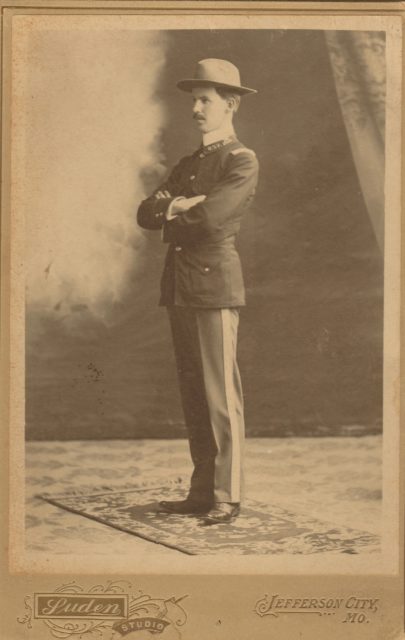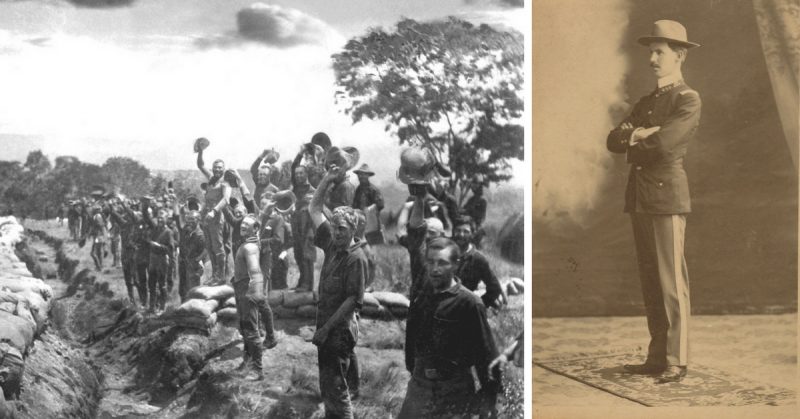War History online proudly presents this Guest Piece from Jeremy P. Ämick, who is a military historian and writes on behalf of the Silver Star Families of America.
A photograph captures a specific point in time, oftentimes providing the viewer with an insight into bygone days. For one local veteran, however, it is not only a glimpse into the period of the Spanish-American War, but points to a distinct moment in a long and interesting military career that spans service in the regular army, Missouri National Guard and Marine Corps.
The photograph inspiring such an investigation is that of Leof Harding, drawing attention to our state’s proud military tradition and a conflict that would help establish the United States as a major player on the world stage.
Born near the community of Virgil City in Vernon County, Missouri, in 1869, records accessed through the Find A Grave website note that Harding’s father, a farmer named Jacob “Nathan” Monroe Harding, passed away the same year as his son’s birth.
The loss of his father, though likely devastating to his many young siblings, did not seem to detract Harding from the pursuit of a storied military career, which began with the regular army sometime prior to 1898 as noted in the May 16, 1898 edition of the St. Louis Post-Dispatch.
Muster rolls from the Missouri State Archives indicate Harding transitioned to service with the Missouri Militia (predecessor of the Missouri National Guard) on April 27, 1898, when Col. William K. Caffee enrolled him in the Second Missouri Volunteers in Nevada, Missouri. The May 16, 1898 edition of the St. Louis Post Dispatch reported that Gov. Stephens commissioned Harding as “first lieutenant and battalion adjutant for the regiment.”
As noted in the “Report of the Adjutant General of Missouri: January 1, 1917 – December 31, 1920,” the itinerant veteran soon joined the regiment in their volunteering for the Spanish-American War when they mustered into service “at Jefferson Barracks on May 12, 1898.”
Days later, the report explained, the regiment “moved to Chickamauga (Georgia) where (they) were assigned to the Third Brigade, Third Division, First Army Corps.” While in training, Lieutenant Otto Fleming resigned his position with Company L of Jefferson City on August 4, 1898—a vacancy that was filled by Lieutenant Harding, as noted in “A History of Jefferson City” by James E. Ford.
The Missouri regiment later spent time in camp in Lexington, Kentucky, and finally at Albany, Georgia, where they remained until mustering out of federal service on March 3, 1899, never deploying overseas in support of the war against Spain.

Though many soldiers returned to their Missouri communities and packed away their military uniforms, the July 8, 1899 edition of The Portsmouth Herald (New Hampshire) reported that Harding chose to continue his military career when he accepted a reduction in rank and appointment as a second lieutenant with the Marine Corps.
Two years later, the officer participated in a number of interesting assignments, including service as judge advocate in the trial of a military paymaster accused of scandalous conduct and then as the officer in charge of the opening of a Marine Corps recruiting station in Pittsburg, Pennsylvania.
His military experience demonstrated an intriguing evolution when the Scott County Kicker newspaper (Benton, Missouri) reported that the lieutenant’s wife gained the “unique distinction of being the only American woman” on the island-municipality of Culebra, Puerto Rico.
The “Report of the Secretary of the Navy” notes that Lt. Harding was placed in command of “(t)he few men left at Culebra.” Additionally, the report said, “Harding was commanded to make a survey of the Government land on the island” and continued “the work on the magazine and gun emplacements”—all of which earned him a commemorative diploma from the Marine Corps’ commandant in recognition of his “valuable services.”
The next decade was a sustained, feverish tempo of duties such as the command of Marines at Mare Island, California, officer-in-charge of the Recruiting District of California, commander of the Marine Barracks in both San Francisco and Sitka, Alaska, and judge advocate in the trial of a naval surgeon undergoing a court martial for allegations of drunkenness.
Retiring from active duty at the rank of captain, it was noted in the August 4, 1918 edition The Washington Herald (Washington, D.C.) that Harding was recommended (and later confirmed) for promotion to major as part of “clauses in the new naval appropriation act that provide for promotion of retired officers on active duty …”
Later documentation indicates the retired officer and his wife remained in California, living in the town of Redlands where he served as an officer on the board of the community’s country club. Harding passed away on March 22, 1961 in San Diego at the advanced age of 91. (His wife had passed away 17 years earlier.)
It is difficult to describe curiosity that compels a person to research the subject of a photograph such as that of Spanish-American War veteran Leof Harding; yet in this process of investigation a life emerges from the ashes of history, casting a light upon a person whose life teemed with interesting experiences.
To borrow a phrase from American novelist Tatjana Soli in her award-winning book “The Lotus Eaters,” the author describes the enchanting process that unfolds when seeking to personify a photograph of a person, such as the long-deceased Major Harding and his role in the Spanish-American War.
“Pictures could not be accessories to the story—evidence—they had to contain the story within the frame; the best picture contained a whole war within one frame.”
